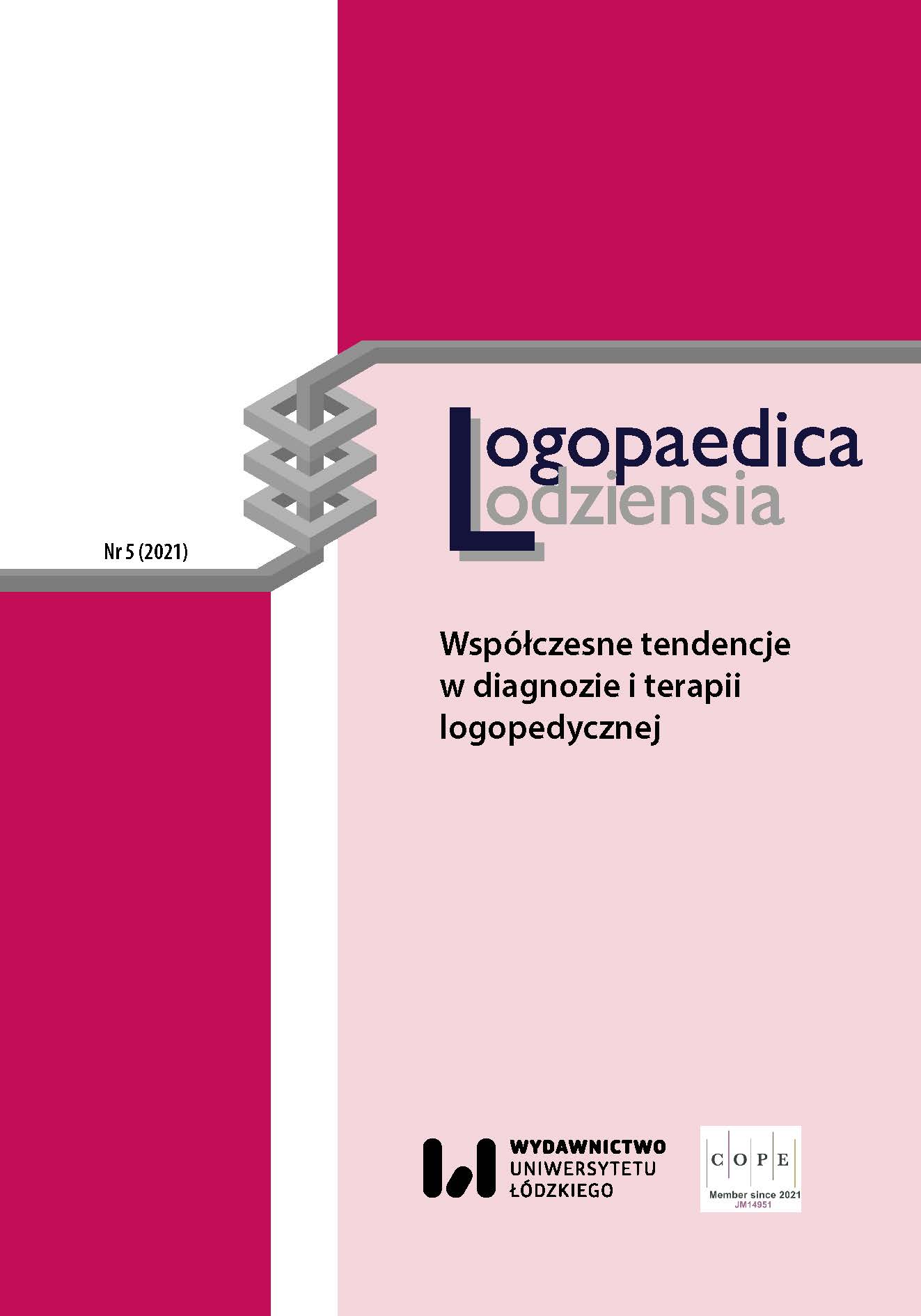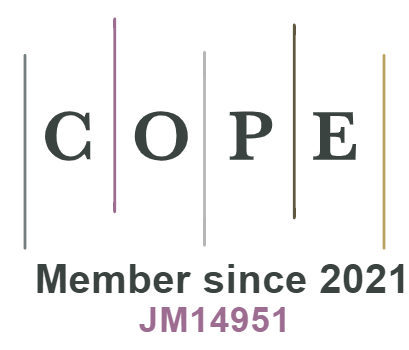Assessment of Childhood Bilingualism Using the RIOT Formula
DOI:
https://doi.org/10.18778/2544-7238.05.10Keywords:
bilingualism, diagnosis, RIOTAbstract
International standards in speech-language pathology provide for different formulas for the diagnosis of multilingual (including bilingual) children. One of them is RIOT (Review, Interaction, Observation, Test), based on the ethnographic study of the patient/client in various contexts, analysis of the collected documentation and testing of linguistic competence. This work is an example of the application of the RIOT formula in the study of a bilingual, Polish-Russian girl B. from Belarus. This allowed for a multi-context analysis of the child’s bilingualism, culminating in a diagnosis of Russian and Polish language subsystems.
Downloads
References
ASHA: American Speech-Language-Hearing Association, http://asha.org (dostęp: 14.10.2020).
Google Scholar
Austin J., 2009, Delay, interference and bilingual development: The acquisition of verbal morphology in children learning Basque and Spanish, „International Journal of Bilingualism”, vol. 13(4), s. 447–479.
Google Scholar
DOI: https://doi.org/10.1177/1367006909353234
Banaszkiewicz A., 2015, Studium przypadku (case study) jako metoda badań logopedycznych, [w:] S. Milewski, K. Kaczorowska-Bray (red.), Metodologia badań logopedycznych z perspektywy teorii i praktyki, Gdańsk: Wydawnictwo Harmonia, s. 364–380.
Google Scholar
Bauman-Waengler J., 2012, Articulatory and Phonological Impairments: A Clinical Focus, Boston: Pearson Education.
Google Scholar
Bedore L., Peña E., 2008, Assessment of bilingual children for identification of language impairment: current findings and implications for practice, „International Journal of Bilingual Education and Bilingualism”, no. 11, s. 1–29.
Google Scholar
DOI: https://doi.org/10.2167/beb392.0
Bialystok E., 2001, Bilingualism in development. Language, Literacy & Cognition, Cambridge: Cambridge University Press.
Google Scholar
DOI: https://doi.org/10.1017/CBO9780511605963
Billewicz G., Zioło B., 2012, Kwestionariusz badania mowy, Kraków: Oficyna Wydawnicza „Impuls”.
Google Scholar
Cheng L., 1990, The identification of communicative disorders in Asian–Pacific students, „Journal of Childhood Communication Disorders”, vol. 13(1), s. 113–119.
Google Scholar
DOI: https://doi.org/10.1177/152574019001300112
Cheng L., 1997, Diversity: challenges and implications for assessment, „Journal of Children Communication Development”, vol. 19, no. 1, s. 55–62.
Google Scholar
DOI: https://doi.org/10.1177/152574019701900107
Cheng L., 2006, Lessons from the Da Vinci Code: Working with Bilingual/Multicultural Children and Families, „ASHA Leader”, vol. 11(13), s. 14–15.
Google Scholar
DOI: https://doi.org/10.1044/leader.FTR4.11132006.14
Cheng L., 2007, Improve your assessment of bilingual clients with communication disorders, „Therapy Insider”, no. 37, s. 10.
Google Scholar
DOI: https://doi.org/10.1097/01.NURSE.0000277239.81488.b7
De Lamo White C., Jin L., 2007, Evaluation of speech and language assessment approaches with bilingual children, „International Journal Language & Communication Disorders”, vol. 46(6), s. 613–627.
Google Scholar
DOI: https://doi.org/10.1111/j.1460-6984.2011.00049.x
Dębski R., Młyński R., Redkva M., 2020, The phonological skills of bilingual preschool children speaking Polish and Ukrainian in Poland, „International Journal of Bilingual Education and Bilingualism”, https://doi.org/10.1080/13670050.2020.1791047
Google Scholar
DOI: https://doi.org/10.1080/13670050.2020.1791047
Edwards J., 2006, Foundations of bilingualism, [w:] T. K. Bhatia, W. C. Ritchie (red.), The Handbook of Bilingualism, Oxford: Blackwell, s. 7–31.
Google Scholar
DOI: https://doi.org/10.1002/9780470756997.ch1
Goldstein B., Fabiano-Smith L., 2007, Assessment and intervention for bilingual children with phonological disorders, „ASHA Leader”, vol. 12(2), s. 6–31.
Google Scholar
DOI: https://doi.org/10.1044/leader.FTR2.12022007.6
Grosjean F., 1989, Neurolinguists, beware! The bilingual is not two monolinguals in one person, „Brain and Language”, vol. 36(1), s. 3–15.
Google Scholar
DOI: https://doi.org/10.1016/0093-934X(89)90048-5
Grosjean F., 2010, Bilingual. Life and reality, Cambridge–London: Harvard University Press.
Google Scholar
DOI: https://doi.org/10.4159/9780674056459
Gruba J., 2017, KOLD – Karty Oceny Logopedycznej Dziecka, Gliwice: Wydawnictwo Komlogo.
Google Scholar
Gutierrez-Clellen V., Peña E., 2001, Dynamic Assessment of Diverse Children, „Language, Speech, and Hearing Services in Schools”, vol. 31(4), s. 212–224.
Google Scholar
DOI: https://doi.org/10.1044/0161-1461(2001/019)
Hegde M., Maul Ch., 2006, Language disorders in children: an evidence-based approach to assessment and treatment, Fresno: Pearson.
Google Scholar
Houwer A. de, 2009, Introduction to Bilingual Development, Bristol–Buffalo–Toronto: Multilingual Matters.
Google Scholar
Hwa-Froelich D., Westby C., 2003, Considerations when working with interpreters, „Communication Disorders Quarterly”, vol. 24(2), s. 78–85.
Google Scholar
DOI: https://doi.org/10.1177/15257401030240020401
IALP: International Association of Communication Sciences and Disorders, http://ialpasoc.info (dostęp: 14.10.2020).
Google Scholar
Jaroszewicz M., 2018, Migracje z Ukrainy do Polski. Stabilizacja trendu, Warszawa: Ośrodek Studiów Wschodnich.
Google Scholar
Jassem W., 2003, Illustration of the IPA: Polish, „Journal of International Phonetic Association”, vol. 33(1), s. 103–107.
Google Scholar
DOI: https://doi.org/10.1017/S0025100303001191
Kłymonczuk W., 2015, Ukraina w poszukiwaniu wolności – od Rewolucji Godności do wyborów parlamentarnych w 2014 roku, „Wschód Europy”, nr 1(2), s. 93–105.
Google Scholar
DOI: https://doi.org/10.17951/we.2015.1.2.93
Kohnert K., 2013, Language disorders in bilingual children and adults, San Diego: Plural Publishing Inc.
Google Scholar
Kohnert K., Medina A., 2009, Bilingual children and communication disorders. A 30-year research retrospective, „Seminars in Speech and Language”, vol. 30(4), s. 219–233.
Google Scholar
DOI: https://doi.org/10.1055/s-0029-1241721
Korol A., 2017, Movlennieva kartka z kartynkamy: lohopedychne obstezhennia rivnia movlennievoho rozvytku dytyny, Ternopil: Mandrivets.
Google Scholar
Kostecka W., 2017, Diagnoza i terapia logopedyczna dziecka z wczesną niepłynnością mowy – studium przypadku, [w:] A. Myszka, K. Bieńkowska, I. Marczykowska (red.), Głos – Język – Komunikacja 4. Funkcjonowanie społeczne dzieci z problemami komunikacyjnymi, Rzeszów: Wydawnictwo Uniwersytetu Rzeszowskiego, s. 147–163.
Google Scholar
DOI: https://doi.org/10.15584/978-83-7996-478-9_12
Langdon H., Saenz T., 2015, Working with interpreters and translators, San Diego: Plural Publishing Inc.
Google Scholar
Lidz C., Peña E., 1996, Dynamic assessment: the model, its relevance as a nonbiased approach, and its application to Latino American preschool children, „Language, Speech, and Hearing Services in Schools”, vol. 27(4), s. 367–372.
Google Scholar
DOI: https://doi.org/10.1044/0161-1461.2704.367
Marian V., Blumenfeld H., Kaushanskaya M., 2007, The language experience and proficiency questionnaire (LEAP-Q): Assessing language profiles in bilinguals and multilinguals, „Journal of Speech Language and Hearing Research”, vol. 50(4), s. 940–967.
Google Scholar
DOI: https://doi.org/10.1044/1092-4388(2007/067)
McCarthy K., Mahon M., Rosen S., Evans B., 2014, Speech perception and production by sequential bilingual children: a longitudinal study of voice onset time acquisition, „Child Development”, vol. 85(5), s. 1965–1980.
Google Scholar
DOI: https://doi.org/10.1111/cdev.12275
Michalak-Widera I., Węsierska K., Test do badań przesiewowych mowy, Katowice: Unikat 2.
Google Scholar
Miodunka W., 2015, Biografia językowa jako jedna z metod badania dwujęzyczności, [w:] R. Dębski, W. Miodunka (red.), Bilingwizm polsko-obcy dziś. Od teorii i metodologii badań do studiów przypadków, Kraków: Księgarnia Akademicka, s. 49–87.
Google Scholar
Młyński R., Redkva M., 2019, Diagnoza logopedyczna kompetencji językowych u wielojęzycznych dzieci z Ukrainy, „Logopedia Silesiana”, nr 8, s. 448–460.
Google Scholar
DOI: https://doi.org/10.31261/LOGOPEDIASILESIANA.2019.08.18
Paradis J., Genesee F., 1996, Syntactic acquisition in bilingual children: autonomous or independent?, „Studies in Second Language Acquisition”, no. 18, s. 1–25.
Google Scholar
DOI: https://doi.org/10.1017/S0272263100014662
Peña E., Bedore L., Kester E., 2016, Assessment of language impairment in bilingual children using semantic tasks: two languages classify better than one, „International Journal Language & Communication Disorders”, vol. 51(2), s. 192–202.
Google Scholar
DOI: https://doi.org/10.1111/1460-6984.12199
Peña E., Quinn R., Iglesias A., 1992, The application of dynamic assessment: a nonbiased procedure, „Journal of Special Education”, vol. 26(3), s. 269–280.
Google Scholar
DOI: https://doi.org/10.1177/002246699202600304
RCSLT: The Royal College of Speech and Language Therapists, http://rcslt.org (dostęp: 14.10.2020).
Google Scholar
Rimikis S., Smiljanic R., Calandruccio L., 2013, Nonnative English speaker performance on the Basic English Lexicon (BEL) sentences, „Journal of Speech, Language and Hearing Research”, vol. 56, s. 792–804.
Google Scholar
DOI: https://doi.org/10.1044/1092-4388(2012/12-0178)
Tzivinikou S., 2005, Identification and differential diagnosis of developmental speech problems in a bilingual child, „Early Child Development and Care”, vol. 175(2), s. 165–178.
Google Scholar
DOI: https://doi.org/10.1080/0300443042000230357
UDSC: Urząd do spraw Cudzoziemców, http://udsc.gov.pl (dostęp: 8.10.2020).
Google Scholar
Ukrainetz T., Harpell S., Walsh C., Coyle C., 2000, A preliminary investigation of dynamic assessment with Native American kindergartners, „Language, Speech and Hearing Services in Schools”, no. 31, s. 142–154.
Google Scholar
DOI: https://doi.org/10.1044/0161-1461.3102.142
Westby C., Burda A., Mehta Z., 1990, Asking the right questions in the right ways – strategies for ethnographic interviewing, „Journal of Childhood Communication Disorders”, vol. 13(1), s. 101–111.
Google Scholar
DOI: https://doi.org/10.1177/152574019001300111
Yanushevskaya I., Bunčić D., 2015, Illustrations of the IPA: Russian, „Journal of the International Phonetic Association”, vol. 45(2), s. 221–228.
Google Scholar
DOI: https://doi.org/10.1017/S0025100314000395
Zurer-Pearson B., Fernandez S., Kimbrough O., 1993, Lexical development in bilingual infants and toddlers: comparison to monolingual norms, „Language Learning”, vol. 43(1), s. 93–120.
Google Scholar
DOI: https://doi.org/10.1111/j.1467-1770.1993.tb00174.x
Downloads
Published
How to Cite
Issue
Section
License

This work is licensed under a Creative Commons Attribution-NonCommercial-NoDerivatives 4.0 International License.












